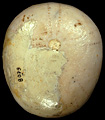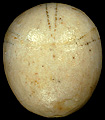The Echinoid Directory
Contributed by Philippe Nicolleau, April 2009
Smithiaster Barras 2007, p. 158
| Diagnostic Features |
|
|---|---|
| Distribution | Upper Jurassic (Callovian to Kimmeridgian), Europe, Morocco, Algeria. |
| Name gender | masculine |
| Type | Dysaster loryi Gras 1852, p. 49, by designation of Barras, 2007, p. 158. |
| Species Included |
|
| Classification and/or Status | Irregularia, stem group Atelostomata, Collyritidae. |
| Remarks | Differs from the type species of Collyrites in having a much shorter distance between the bivium and trivium sections of its apical disc. Eoholaster differs from Smithiaster in having its bivium farther from the periproct and in having only a very short distance between the bivium and trivium. In Smithiaster the distance separating the bivium and anus is between 0.23 and 0.30 of the total length of the test. Barras (2007, p. 158) chose Dysaster loryi as type species of this genus but unfortunately figured and based his description and diagnosis on a wrongly identified specimen (Museum National d'Histoire Naturelle, Paris A24446) which is, in reality, a Eoholaster lafittei. Barras, C. 2007. Phylogeny of the Jurassic to Early Cretaceous 'disasteroid' echinoids (Echinoidea; Echinodermata), and the origins of spatangoids and holasteroids. Journal of Systematic Palaeontology 5, 133-161. Vadet, A. 2008. Echinides nouveaux, peu ou mal connus. Annales de la societe d'Histoire Naturelle du Boulonnais 6 fasc. 2. |
| Contributor comments: | Barras 2007 p158 choose the type Dysaster loryi but he figure (5A-B; pl.2, fig. 8a-c) an Eoholaster lafittei A24446 from the Lambert's collection (MNHN de Paris), probably from the localit�© type the Djebel Azreg. [Philippe Nicolleau, April 2009] Treated here as a junior synonym of Collyrites. [Andrew Smith, April 2009] |





